| |
What is calculus?
Calculus is a double problem: it threatens the good health of your teeth and gums, and is very ungraceful.
There are two sorts of calculus :
- Sub-gingival calculus (along the roots)
- Supra-gingival calculus (visible on the teeth)
Tartar mostly forms in areas near salivary glands, which are on the lingual side of the inferior incisors and on the labial side of the superior molars.
It is calcified form of dental plaque, originating from minerals contained in saliva (calcium ions). Calculus is porous and rough. It enables a new dental plaque retention, that will calcify and add to the existing coating.
Calculus is in fact made of small empty cells, not of living bacteria. It is not in itself harmful but its accumulation creates gingival lesions, promoting inflammation, and so on gum bleeding. If the bleeding becomes serious, there could be osseous lesions leading to tooth mobility and halitosis (bad breath).
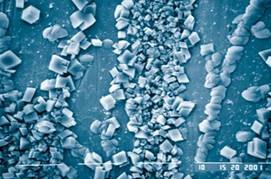 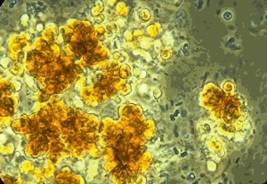
Most patients think they have a good oral hygiene and thus a "clean mouth". Actually, the reality is very different: when we perform a bacterial and dental plaque check-up, we are often disillusioned with what we see, and the consequences are then perceptible: bleedings, tooth mobility, bad breath, teeth working loose, gum infections, etc...
Our role : Optimizing your daily gesture and habits. It is performed in our office by Natacha, our advisor in oral hygiene.
Teeth cleaning
Calculus primarily forms on the lower incisors' lingual face (on the side of the tongue). It can also be found on the first superior molars on the vestibular face (on the side of the cheek). Other areas of the mouth are less prone to tartar but still accessible in extreme cases.
Depending on the person, calculus can built either fast or slowly.
Different factors come into consideration : |
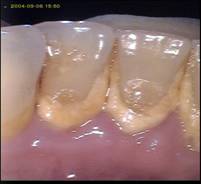 |
Brushing efficiency: the better the dental plaque is removed, the less tarter will form.
- Saliva: it can be a tartar building factor considering pH variations,
the buffering capacity, quantity...
- Tobacco: it is a harmful substance for the periodontium.
Teeth cleaning
Calculus is the result of dental plaque calcification. Keeping it for too long can lead to an inevitable premature tooth loosening and thus to teeth loss.
A teeth cleaning consists in removing all the calculus coating fixed on the dental surfaces and especially in between the teeth. |
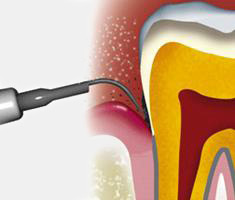 |
The cleaning is performed with high frequency vibrations using ultrasound and water irrigation, enabling the dislocation of calculus and other debris fixed on the teeth without causing any harm to the tooth enamel. Most of the time, a teeth cleaning will be painless, but it is possible for patients with loose teeth to feel a minor discomfort during the treatment. Some patients showing very specific pathologies will be required to follow a preliminary antibiotic treatment and/or a one month program using the "Mons paste" prior to the teeth cleaning. Indeed, this simple procedure can lead to microorganisms passing through the blood circulation and thus causing health difficulties. |
Frequency
The necessity of a teeth cleaning varies among people, considering calculus growth speed, the patient's sensitivity to periodontal diseases, the quality of his tooth brushing or other personal factors (tobacco consumption, his saliva's quality...). The frequency can go from once every 3 months to once every few years.
It is for this reason that most practitioners recommend a teeth cleaning once a year, at the same time of an annual medical visit. A teeth cleaning is not a teeth-whitening treatment, even though it does whiten the teeth as tartar has a yellowish colour.
Lithotripsy
It consists in removing bacteria and calculus deep into the periodontal pockets using specific instruments (infrasound, optical fiber, air stream).
• This procedure does not need any gum detachment or stitches.
• Multiple sessions are required.
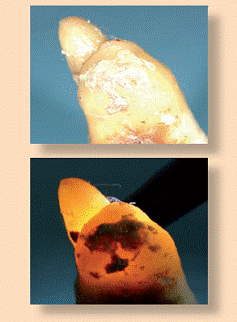
Optic fiber used to trans illumination.
The calculus can be seen directly on the root.
|
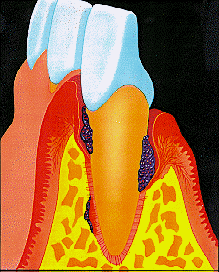 |
|
|
|

